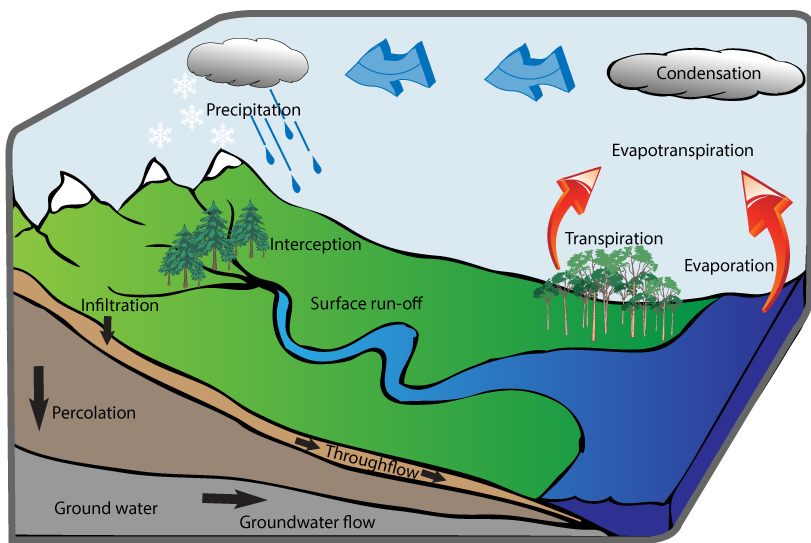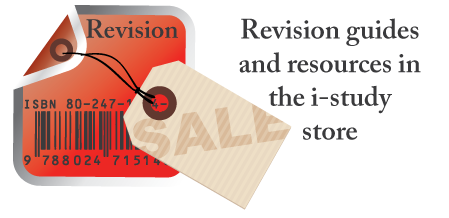The hydrological system
You should have an understanding of the impact of human activity on the hydrological cycle:
- Deforestation: trees intercept rain and remove water from the soil layers. Deforestation leads to more surface runoff into rivers and saturation of soil - often causing flooding. Trees also reduce soil erosion: leaves reduce the impact of raindrops on soil, roots hold soil in place.
- Urbanisation: urban areas cover permeable surfaces with impermeable surfaces - reducing infiltration and increasing surface runoff into rivers.
- Climate change: melting of glaciers means more water in rivers. Less snowfall and more rainfall - less water stored as ice. Agriculture: large volumes of water are extracted from river systems and aquifers - depleting river flow and groundwater stores.

Ocean Circulation
You should have an understanding of how the oceans redistribute heat through surface and deepwater currents
These currents play an essential role in regulating the climate and supporting fish stocks and coral reefs. Any significant changes in ocean currents are likely to destabilise many other living systems.
Ocean circulation systems are driven by differences in temperature and salinity. The resulting difference in water density drives the ocean conveyor belt, which distributes heat around the world, and thus affects climate.
Warm currents flow on the surfaces of the oceans, the cold currents are deeper.
The 'Gulf Stream' which is the warm current flowing from the Caribbean northwards brings warmer water to Northern Europe and moderates its climate.
Groundwater Extraction
Groundwater depletion examples
A new model simulating regional groundwater dynamics and withdrawals from 1960 to 2100 found that:
- California’s agricultural powerhouses—the Central Valley, Tulare Basin, and southern San Joaquin Valley, which produce a plentiful portion of the nation’s food—could run out of accessible groundwater as early as the 2030s.
- India’s Upper Ganges Basin and southern Spain and Italy could be used up between 2040 and 2060.
- And the southern part of the Ogallala aquifer under Kansas, Oklahoma, Texas, and New Mexico could be depleted between 2050 and 2070.
Case Study: The Colorado River
The Colorado River no longer reaches the sea
Read fig 4.21 to answer the following questions in full sentences:
- Where is the source of the Colorado River?
- How long is the Colorado River?
- How many people rely on the water from the Colorado?
- How many dams have been built along the Colorado?
- Describe how agriculture and urban growth have extracted all its water.
Use this Guardian article to answer the following questions:
- Why is a Saudi Arabian farm operating in America?
- How much land do they own now?
- What crop are they growing and why?
- Should America continue to allow virtual water to be exported to Saudi Arabia and other countries through alfalfa production?
- Based on what you have learnt about the Colorado River, discuss whether the economic benefits that the river brings are worth the environmental cost of the river not reaching the sea?
Conflict over Freshwater
The River Nile
The River Nile has 2 main tributaries (Blue and White Nile) and flows through several African countries. Egypt, South and North Sudan are almost completely reliant on the Nile for their freshwater supplies. With very little rainfall, rising populations and increasingly energy intensive industries and lifestyles the Niles water is more important than ever.
Ethiopia and Sudan also have rising populations and a need for more electricity and water for irrigation. They have both talked about damming the Nile, closer to its sources. Doing this could have major implications for water security in Egypt and North/South Sudan. Ethiopia is in the process of building a hugely contraversial dam - The Grand Reneissance Dam.
Watch the video and makes notes about the following:
- Where is the dam being built?
- Why is the dam being built? Extend your answer to think about the reasons behind the need.
- Which other countries rely on the Nile water?
- Why is the dam causing so much international conflict?
Contrasting Fishery Management
Case Study: Newfoundland Cod Fisheries
Restrictions in place on Cod Fishing in Newfoundland:
An Harvest Control Rule (HCR) for cod has been in place since 2007, though the directed fishery has been under moratorium since 1994 to give the stock an opportunity to rebuild...Since the Atlantic cod is a recovering stock, there are interim and long-term management objectives.
The fishery will remain closed until there is a “very low” probability—defined as less than 10 percent likelihood—of being below adult biomass targets. Once the fishery can reopen, the catch limit will be set to result in continued growth. For the Atlantic cod, adult biomass has increased considerably since 2010. Therefore, the fishery remains closed and bycatch is “restricted to unavoidable bycatch.”
Source: Pewtrusts
Case Study: Icelandic Cod Fisheries
Contrasting Fishery Management
Case Study: Icelandic Cod Fisheries

